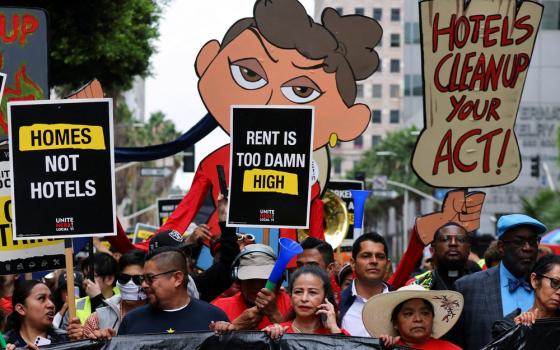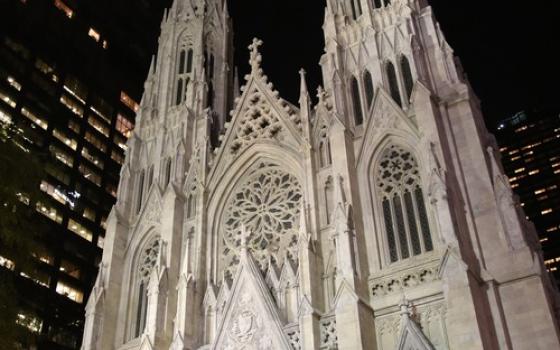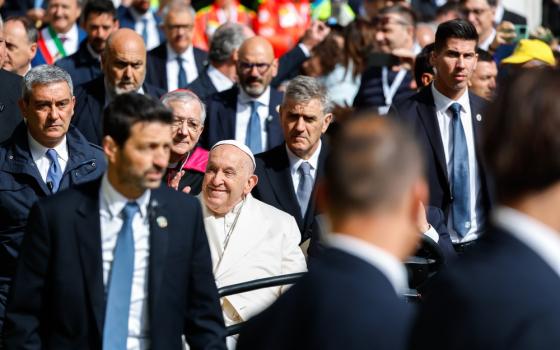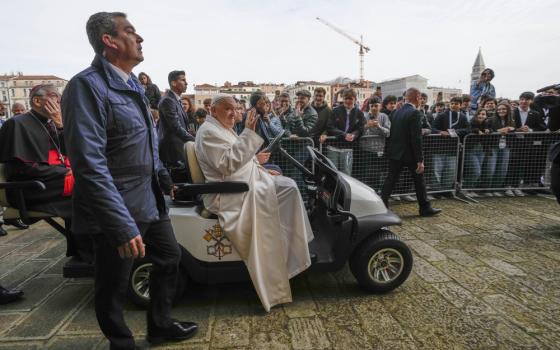THE LOOK OF CATHOLICS: PORTRAYALS IN POPULAR CULTURE FROM THE GREAT DEPRESSION TO THE COLD WAR
By Anthony Burke Smith
Published by University Press of Kansas, $34.95
In the 1944 movie “Going My Way,” Fr. Chuck O’Malley (Bing Crosby) didn’t look like a Catholic. Instead of a black cassock, he wore a St. Louis Browns sweatshirt. Instead of pacing sedately with his breviary, he hurdled bushes on his way to church. And instead of singing solemn hymns, he belted out catchy little tunes while playing ragtime on the piano.
But he did pray like a Catholic, or at least like a Catholic of the 1940s. He knelt before a statue of St. Joseph and the child Jesus, crossed himself, and lit a candle, remembering to place a few coins in the collection box.
 What did a Catholic look like? Anthony Burke Smith’s new book, The Look of Catholics: Portrayals in Popular Culture from the Great Depression to the Cold War, is a fascinating and rich evaluation of how Catholics were depicted in movies, television programs, and magazines from the 1930s to the 1960s. Smith’s central thesis is that, as he says, “popular representations of and by Catholics provided an important cultural arena for expressing competing understandings of Americanism between the New Deal and Cold War eras.” In other words, looking at how Catholics were portrayed in popular culture can frequently tell us what issues Americans were struggling with both internally and in relation to the rest of the world.
What did a Catholic look like? Anthony Burke Smith’s new book, The Look of Catholics: Portrayals in Popular Culture from the Great Depression to the Cold War, is a fascinating and rich evaluation of how Catholics were depicted in movies, television programs, and magazines from the 1930s to the 1960s. Smith’s central thesis is that, as he says, “popular representations of and by Catholics provided an important cultural arena for expressing competing understandings of Americanism between the New Deal and Cold War eras.” In other words, looking at how Catholics were portrayed in popular culture can frequently tell us what issues Americans were struggling with both internally and in relation to the rest of the world.
For example, in movies of the 1930s, Catholic characters were used by filmmakers to embody society’s call for social cooperation, interdependence and looking out for the little guy. Films like “Boys Town” and “Angels with Dirty Faces” (both released in 1938) featured Catholic priests working for and with the urban, ethnic poor. These clerical champions of forgotten youth and underdogs urged America to embrace a reformist narrative that meshed nicely with Roosevelt’s New Deal.
Things changed in the 1940s as Crosby’s suave, sophisticated Fr. O’Malley filled the screen. Smith writes, “At stake in ‘Going My Way’ was nothing less than a symbolic cleansing of the streets of urban America, ridding them of all the critical, reformist energies that Hollywood had recognized in the 1930s.” Gone were the tenements and prisons of earlier films. Instead, the golf-playing O’Malley offered viewers “a familiar, reassuring world of respectability and propriety.” In a world overrun by war, viewers found solace in a priest who preached traditional values with unthreatening and upbeat ditties.
By the 1950s, as communism posed an increasing threat to Christianity, Catholics appeared in popular culture as good Americans whose families and homes were bulwarks against godless tyranny. Archbishop Fulton Sheen’s television program “Life Is Worth Living,” for example, urged viewers to see the mundane world of marriage and children as, says Smith, “the context for the pilgrimage of the soul.” Instead of looking outward and attempting to change corrupt and unjust social conditions, the message that Catholics offered and received was that the best weapons against communism were found inside one’s home and inside one’s self.
One of the most intriguing chapters in Smith’s book focuses on Life magazine and its editor in chief, Henry R. Luce. In its earliest years, notes Smith, Life portrayed Catholics as foreigners and strangers who were set apart from mainstream society. In the late 1940s, however, influenced no doubt by the conversion to Catholicism of Henry’s wife Clare Booth Luce, the magazine began to depict Catholics as a potent moral force against communism. Publishing stories about Catholics thus helped to further the magazine’s project of “celebrating the United States as a free society in contrast to the oppression of Soviet totalitarianism.”
This effort to Americanize Catholic life can be seen in a 1954 article about the Society of Jesus. The story featured profiles of clean-cut young Jesuits immersed in the modern world: piloting airplanes, building dams and staging plays.
Other chapters of note include an in-depth analysis of the films of Catholic director Leo McCarey (whose films include “Going My Way”) and an examination of the movies directed by John Ford, whose Westerns such as “Stagecoach” (1939) and “Fort Apache” (1948) explored the edges of what it meant to be American. (For analysis of more contemporary representations of Catholicism in popular culture, see Colleen McDannell’s edited volume Catholics in the Movies, to which Smith [and -- full disclosure -- I as well] contributed chapters.)
The power of The Look of Catholics comes from its author’s broad vision of the cultural and political trends that shaped both American Catholic life and how that life was portrayed in media. At times Smith compares depictions of Catholics to depictions of Protestant religious life, and at times he sets such comparisons against larger historical frameworks. One feels reading the book that one is getting a nuanced but expansive presentation of the religious, political and economic trends that shaped how Catholics were presented in popular culture in the middle decades of the last century.
[Theresa Sanders is associate professor of theology at Georgetown University in Washington. Her most recent book is Approaching Eden: Adam and Eve in Popular Culture (Rowman & Littlefield, 2009).]



